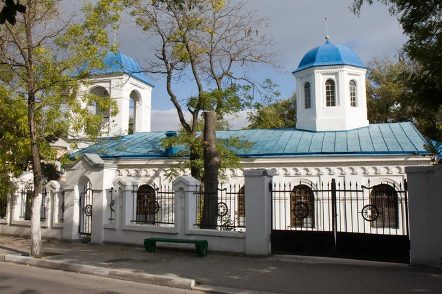

Location: Feodosiya
Vvedenskaya Church in Feodosiya is a Russian Orthodox Church in Feodosiya in Crimean Peninsula, Ukraine. It is considered to be the oldest surviving structure in the city. This beautiful building was erected on the ruins of much older Byzantine Orthodox church that dates back to the 7th century AD. Vvedenskaya Church of Feodosiya consists of several structures. The oldest part is the Byzantine chapel. Other rooms served as a school for local kids and private residence of the priest who once lived here. Vvedenskaya Church served a large community of Greeks that settled these shores since the ancient times so services were held in two languages: Greek and Russian.
Foundation
Initially, the Vvedenskaya Church was similar to the
Greek Church of St. Demetrius of Thessalonica. The exact time of
construction has not been established, usually referred to as the
VIII-IX centuries.
new time
In 1787, the church was declared
the cathedral church of the semi-independent Feodosiya diocese. Then the
temple belonged to the Greek community of Feodosia. There was a priest's
house in the yard, "Eliniko Skolio" (Greek four-year school) worked. It
was opened in 1891 by patrons Manuil and Skiragda Grammatikov. The
church owned a chapel two kilometers away, commercial premises, a garden
and a dacha.
In 1825 a bell tower was built from white stone, in
1854 a large extension was built. At the same time, stone carving and
frescoes appeared inside the temple. The dome was inlaid with colored
glass. The altar is small with three arches and one window. Throne on
four stone pillars with a marble top board. Between the pillars are
depicted: on the east side - the resurrection of Lazarus, on the west
side - the Resurrection of Christ, on the north side - the removal of
the Savior from the cross, on the south side - the crucifixion on the
cross. Altar in the wall. The iconostasis in the Byzantine style was
created back in 1776, but in 1882 it was transferred to the prison
church and replaced with a new one. Above the royal doors - radiance.
The inscription is superimposed in wooden Greek letters: "Come with the
fear of God and with faith and love."
In 1861, during his visit
to Feodosia, the Russian emperor Alexander II visited the cathedral.
In the 20th century
The service was conducted in Church Slavonic
and Greek even in the first half of the 20th century. In 1937 the church
was closed, members of the local Greek church community were shot.
Hieromartyr Bartholomew (Ratnykh) was famous.
The bell tower and
fence, the dome were destroyed, the frescoes were painted over, the
stone carving was knocked down. The church became a gymnasium with a
coaching team and locker rooms.
It consists of two parts - a small Byzantine church of the hall type and an extension with a bell tower of the 19th century. Modern murals date from the beginning of the 21st century. In December 1993, the church was returned to parishioners. The dome and bell tower were restored, as well as the fence.